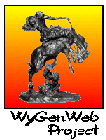History of Niobrara County
Niobrara County, WY was created in 1911 from the eastern part of Converse County, WY. It was organized in 1913 and named by Harry S. Snyder after the Niobrara River which rises west of Lusk, Niobrara County seat.
The name "Niobrara" is taken from the Omaha-Ponca Indian name Ni (water) obthatha (spreading) ke (horizontally). It was called "Running Water" by early settlers. The Cheyenne Indian name for the Niobrara was Hisse yovi yoe, which means unexpected or surprise river. They came upon it suddenly on the prairie, as it is marked with few trees.
Niobrara County Locations
- Ant Hills
- Three knolls shaped like ant hills in an oil producing district.
- Bright
- Used to be Warren. The post office was established in 1898 at ULA ranch which was named for the owner's daughter, Eula Wulfjen. This discontinued post office was named for Joe Bright, postmaster.
- Chimney Rock
- About nine miles north of Lusk, east of Highway 85; near Hat Rock. Chimney Rock was named for its shape.
- Dale
- Discontinued post office at the mouth of Alkali Creek. So named because Fred Dale was instrumental in starting it in about 1900.
- Dogie
- A discontinued post office. Mrs. Reta A. Butler, first postmaster, wanted the name "Eureka" because she liked the country. The Post Office Department said no so she chose "Dogie" for a motherless calf.
- Fort Hat Creek
- After gold was discovered in the Black Hills in 1874, Captain Egan and a force of cavalry were sent out from Fort Laramie to establish a fort on Hat Creek in Nebraska. Wandering in unmarked wilderness they came to Sage Creek. Thinking it was Hat Creek they built a fort close to water and wood in 1875. The fort passed into private ownership in 1876. It became an important stage stop on the Cheyenne-Deadwood route.
- Harding Ranch
- A stage stop on the Cheyenne-Deadwood trail. A dugout fort in a clay bank. It had a log roof and portholes, a dugout stable for horses, and station owner Harding served meals. It was also known as Indian Creek stage stop.
- Hat Creek
- One of the main stations on the Cheyenne-Deadwood stage line. In 1877, Jack Bowman advertised that he would "furnish accommodations to the traveling public at reasonable rates." The stop had a blacksmith shop, brewery, bakery, hotel, post office, and later, a telegraph station. Buffalo were killed here as late as 1878. John Storrie and Tom Swan erected a two-story store in the 1880s that was popular with cowboys and as a stage stop. The route to the north of Hat Creek station was the most dangerous section due to Indians and road agent robbers. The route divided here, one way going by Indian Creek and another north to the Cheyenne River. The main building then, a large structure, is still in use as a ranch home. A post office was established in 1877 according to postal records.
- Keeline
- Lance Creek
- Lusk
- Frank Lusk, who provided land for a railroad station and a town when
land was needed in 1886, also gifted the resulting town with his
name. Its early economic history included mining for silver and
radium, and Lusk has had its share of oil booms and busts, but its
contemporary focus is on ranching and dry farming.
Every year the town is the site of the re-enactment of one of the most gruesome episodes in the history of the West: the Legend of Rawhide.
The legend has it that a member of a passing wagon train murdered a young Indian maiden. The Indians, naturally, were incensed. They demanded that the leadership of the wagon train yield the murderer to their justice, and promised that, if the whites did so, the innocents among them could go on their way unmolested. If they did not, however, the consequences would be dire.
After pondering their prospects, the wagon train's leaders turned over the murderer. The rest of the story is told by the pageant.
- Manville
- Node
- Van Tassell
Historic sites in Niobrara County
- Agate Basin Archeological Site (NO201)
- C&H Refinery District, Lusk (NO410)
- Ferdinand Branstetter Post No. 1 American Legion (NO5)
- Bridge Over Cheyenne River (NO293)
- Cheyenne Black Hills Stage Route - Running Water (NO41)
- Lusk Water Tower (NO146)
Other History Links
- Fort Laramie - along the Cheyenne-Deadwood Stage Route
- Cheyenne-Deadwood Stage - Black Hills Visitor Magazine
- Deadwood Stage - Lost treasure of the Deadwood Stage, from Treasure Cache Magazine
- More Cheyenne-Deadwood Stage
- Historical Archives from the Niobrara County Library
Maps and Land Records
-
Wyoming Territory, 1879, at Ancestry.Com
- 1895 Map of Wyoming
- 1897 Map of Wyoming - Excellent detail!
- BLM Land Patents - Niobrara County patents now on-line!
-
Indian Reservations, 1840
-
Indian Reservations, 1875
-
Indian Reservations, 1900
-
Indian Reservations, 1930
If you have any additions, corrections, or any information you would like to contribute to these pages, please contact me at sleonard@wyoming.com.

